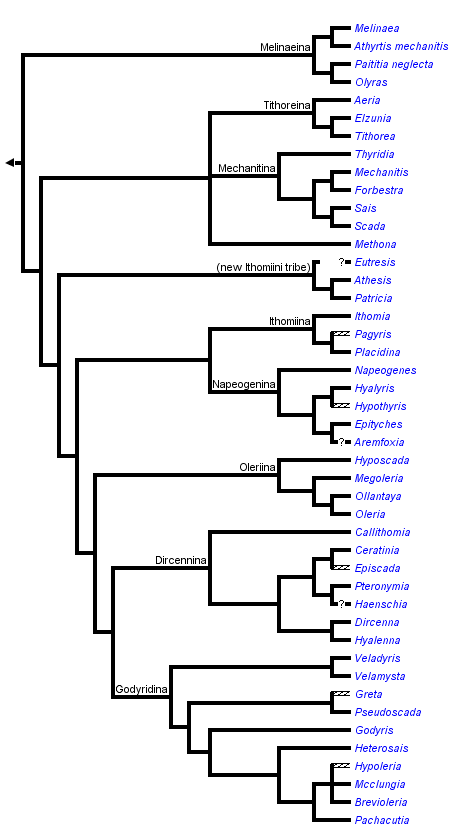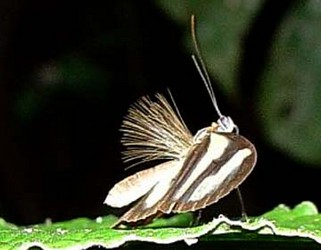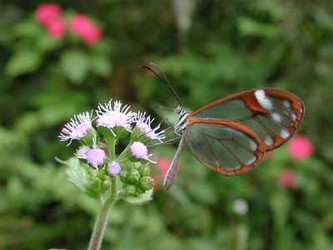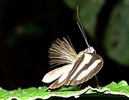Ithomiini
Clearwing Butterflies
Andrew V. Z. Brower and Chris Jiggins


This tree diagram shows the relationships between several groups of organisms.
The root of the current tree connects the organisms featured in this tree to their containing group and the rest of the Tree of Life. The basal branching point in the tree represents the ancestor of the other groups in the tree. This ancestor diversified over time into several descendent subgroups, which are represented as internal nodes and terminal taxa to the right.

You can click on the root to travel down the Tree of Life all the way to the root of all Life, and you can click on the names of descendent subgroups to travel up the Tree of Life all the way to individual species.
For more information on ToL tree formatting, please see Interpreting the Tree or Classification. To learn more about phylogenetic trees, please visit our Phylogenetic Biology pages.
close boxIntroduction
The ithomiine butterflies are a diverse neotropical group of approximately 370 species that show huge diversity of colour pattern and form (Lamas 2004). Most species are involved in Müllerian mimicry with one another and serve as models in mimicry complexes with other Lepidoptera, including the heliconiines and the danaine genus Lycorea.
Characteristics
The chemical ecology of these butterflies is fairly well known. Larvae of relatively basal Tithoreina feed on host plants in the family Apocynaceae, a host plant group shared with the related danaine butterflies. Most species, however feed on the Solanaceae (nightshades), which is a very speciose and chemically diverse plant family. Most ithomiines are thought to be distasteful to predators, but interestingly some species do not sequester chemicals from their larval host plants (Brown 1984a & b). Instead the males collect pyrrolizidine alkaloids from flowers (especially Asteraceae) and rotting leaves (mainly of Boraginaceae). This may be an adaptation to reduce dependence on larval host plant chemicals (Brown, 1987).
Discussion of Phylogenetic Relationships
The most recent revision of ithomiine sub-tribal and generic nomenclature is in the Checklist of Neotropical Lepidoptera (Lamas 2004), upon which the names in this tree and its subtrees are based. Lamas (2004), as well as Willmott and Freitas (2006) view Ithomiinae as a subfamily. Here, the clade is treated as a tribe, in order to accommodate the well-supported monophyly of (Danaini , Tellervini , Ithomiini) as a subfamily within Nymphalidae. Thus, Lamas' tribal names are listed here as subtribes.
The topology is derived from several recent works: the DNA sequence-based phylogenetic hypothesis of Brower et al. (2006), and the extensive morphological work of Willmott and Freitas (2006). It is based in part upon an unpublished combination of data from both. Relationships within Oleriina are based on de Silva et al. (2010). The phylogenetic affinities of three taxa (Eutresis, Haenschia and Aremfoxia) whose phylogenetic positions were not well resolved in Willmott and Freitas (2006) and were not sampled by Brower et al. (2006) are indicated as uncertain.
A few genera are likely paraphyletic with respect to others as currently circumscribed: molecular and morphological evidence both suggest that Pagyris is paraphyletic with respect to Placidina, Hypothyris is paraphyletic with respect to Hyalyris, Episcada is paraphyletic with respect to Ceratinia, Greta is paraphyletic with respect to Pseudoscada. The morphological data further suggests paraphyly of Godyris and Hypoleria.
Nomenclature
Several generic names have been synonymized recently. These include:
- Ceratiscada Brown & d'Almeida 1970 (synonymized with Episcada)
- Dygoris Fox 1945 (synonymized with Godyris)
- Garsauritis d'Almeida 1938 (synonymized with Hypothyris)
- Hypomenitis Fox 1945 (synonymized with Greta)
- Prittwitzia Brown & Ebert 1970 (synonymized with Episcada)
- Rhodussa d'Almeida 1939 (synonymized with Hypothyris)
- Roswellia Fox 1948 (synonymized with Athesis)
- Talamancana Haber, Brown & Freitas 1994 (synonymized with Pteronymia)
References
Brower A. V. Z., A. V. L. Freitas, M.-M. Lee, K. L. Silva-Brandao, A. Whinnett, and K. R. Willmott. 2006. Phylogenetic relationships among the Ithomiini (Lepidoptera: Nymphalidae) inferred from one mitchondrial and two nuclear gene regions. Syst. Ent. 31: 288-301.
Brown, K. S. 1984. Adult-obtained pyrrolizidine alkaloids defend ithomiine butterflies against a spider predator. Nature (London) 309:707-709.
Brown, K. S. 1984. Chemical ecology of dehydropyrrolizidine alkaloids in adult Ithomiinae (Lepidoptera: Nymphalidae). Rev. Brasil. Biol. 44:435-460.
Brown, K. S. 1987. Chemistry at the Solanaceae/Ithomiinae interface. Annals of the Missouri Botanical Garden 74:341-358.
Brown, K. S., and A. V. L. Freitas. 1994. Juvenile stages of Ithomiinae: overview and systematics (Lepidoptera: Nymphalidae). Tropical Lepidoptera 5:9-20.
De Silva, D. L., Day, J. J., Elias, M., Willmott, K., Whinnett, A. & Mallet, J. 2010. Molecular phylogenetics of the neotropical butterfly subtribe Oleriina (Nymphalidae: Danaini: Ithomiini). Mol. Phhylogenet. Evol. 55, 1032-1041.
Fox, R. M. 1940. A generic review of the Ithomiinae (Lepidoptera: Nymphalidae). Transactions of the American Entomological Society 66:161-207.
Fox, R. M. 1968. Ithomiidae (Lepidoptera: Nymphaloidea) of Central America. Transactions of the American Entomological Society 94:155-208.
Lamas, G. 2004. Ithomiinae in J. B. Heppner, ed. Atlas of Neotropical Lepidoptera. Checklist: Part 4A. Hesperioidea - Papilionoidea. Association for Tropical Lepidoptera/Scientific Publishers, Gainsville.
Mallarino, R., E. Bermingham, K. R. Willmott, A. Whinnett, and C. D. Jiggins. 2004. Molecular systematics of the butterfly genus Ithomia (Lepidoptera: Ithomiinae): a composite phylogenetic hypothesis based on seven genes. Molecular Phylogenetics and Evolution 34:625-644.
Willmott, K. R. and A. L. V. Freitas. 2006. Higher-level phylogeny of the Ithomiinae (Lepidoptera: Nymphalidae) : classification, patterns of larval hostplant colonization and diversification. Cladistics 22: 297-368.
Information on the Internet
The butterflies of Monteverde, Costa RicaIllustrated checklist of Ithomiinae
Title Illustrations

| Scientific Name | Aeria eurimedia |
|---|---|
| Location | Amazonia Lodge, Atalaya, Peru |
| Comments | Hairpencils are androconial organs on the costal margin of the hindwing in male ithomiines. They represent a synapomorphy or the tribe. |
| Specimen Condition | Live Specimen |
| Identified By | Kim Garwood |
| Behavior | fanning hairpencils in courtship display |
| Sex | Male |
| Life Cycle Stage | adult |
| View | lateral |
| Source | Yellow-striped clearwing |
| Source Collection | Neotropical Butterflies |
| Copyright | © 2004 Kim Garwood |
| Scientific Name | Greta nero |
|---|---|
| Location | Fortuna, Chiriqui, Panama |
| Specimen Condition | Live Specimen |
| Identified By | C Jiggins |
| Sex | Male |
| Image Use |
 This media file is licensed under the Creative Commons Attribution-NonCommercial-ShareAlike License - Version 3.0. This media file is licensed under the Creative Commons Attribution-NonCommercial-ShareAlike License - Version 3.0.
|
| Copyright |
© 2005 Chris Jiggins

|
About This Page

Middle Tennessee State University, Murfreesboro, Tennessee, USA
Chris Jiggins

University of Cambridge, Cambridge, UK
Correspondence regarding this page should be directed to Andrew V. Z. Brower at and Chris Jiggins at
Page copyright © 2010 and Chris Jiggins
 Page: Tree of Life
Ithomiini . Clearwing Butterflies.
Authored by
Andrew V. Z. Brower and Chris Jiggins.
The TEXT of this page is licensed under the
Creative Commons Attribution License - Version 3.0. Note that images and other media
featured on this page are each governed by their own license, and they may or may not be available
for reuse. Click on an image or a media link to access the media data window, which provides the
relevant licensing information. For the general terms and conditions of ToL material reuse and
redistribution, please see the Tree of Life Copyright
Policies.
Page: Tree of Life
Ithomiini . Clearwing Butterflies.
Authored by
Andrew V. Z. Brower and Chris Jiggins.
The TEXT of this page is licensed under the
Creative Commons Attribution License - Version 3.0. Note that images and other media
featured on this page are each governed by their own license, and they may or may not be available
for reuse. Click on an image or a media link to access the media data window, which provides the
relevant licensing information. For the general terms and conditions of ToL material reuse and
redistribution, please see the Tree of Life Copyright
Policies.
- First online 28 October 2005
- Content changed 21 July 2010
Citing this page:
Brower, Andrew V. Z. and Chris Jiggins. 2010. Ithomiini . Clearwing Butterflies. Version 21 July 2010 (under construction). http://tolweb.org/Ithomiini/27570/2010.07.21 in The Tree of Life Web Project, http://tolweb.org/









 Go to quick links
Go to quick search
Go to navigation for this section of the ToL site
Go to detailed links for the ToL site
Go to quick links
Go to quick search
Go to navigation for this section of the ToL site
Go to detailed links for the ToL site